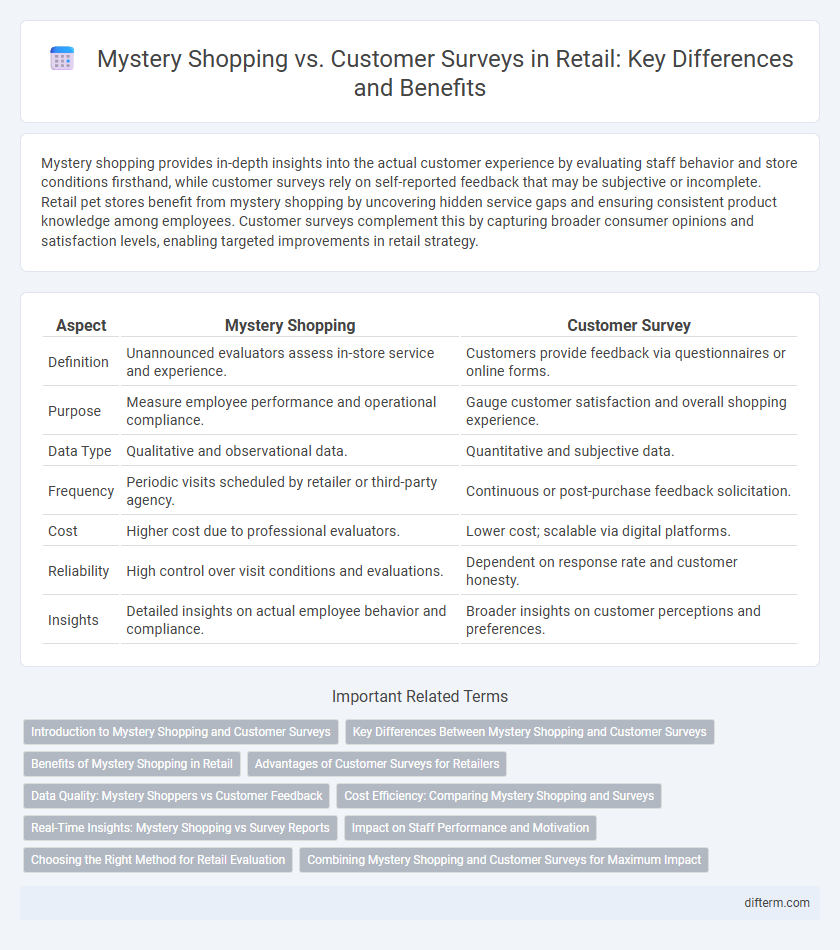Mystery shopping provides in-depth insights into the actual customer experience by evaluating staff behavior and store conditions firsthand, while customer surveys rely on self-reported feedback that may be subjective or incomplete. Retail pet stores benefit from mystery shopping by uncovering hidden service gaps and ensuring consistent product knowledge among employees. Customer surveys complement this by capturing broader consumer opinions and satisfaction levels, enabling targeted improvements in retail strategy.
Table of Comparison
| Aspect | Mystery Shopping | Customer Survey |
|---|---|---|
| Definition | Unannounced evaluators assess in-store service and experience. | Customers provide feedback via questionnaires or online forms. |
| Purpose | Measure employee performance and operational compliance. | Gauge customer satisfaction and overall shopping experience. |
| Data Type | Qualitative and observational data. | Quantitative and subjective data. |
| Frequency | Periodic visits scheduled by retailer or third-party agency. | Continuous or post-purchase feedback solicitation. |
| Cost | Higher cost due to professional evaluators. | Lower cost; scalable via digital platforms. |
| Reliability | High control over visit conditions and evaluations. | Dependent on response rate and customer honesty. |
| Insights | Detailed insights on actual employee behavior and compliance. | Broader insights on customer perceptions and preferences. |
Introduction to Mystery Shopping and Customer Surveys
Mystery shopping involves trained evaluators who anonymously assess retail store operations, providing detailed insights into customer service quality and compliance with company standards. Customer surveys collect direct feedback from shoppers about their experiences, preferences, and satisfaction levels through structured questionnaires. Combining mystery shopping with customer surveys offers a comprehensive understanding of retail performance and consumer perceptions.
Key Differences Between Mystery Shopping and Customer Surveys
Mystery shopping involves trained evaluators posing as customers to assess store operations, staff behavior, and service quality firsthand, while customer surveys gather direct feedback from actual customers about their shopping experiences. Mystery shopping provides qualitative, observational insights on specific interactions, whereas customer surveys offer quantitative data reflecting broader customer satisfaction and preferences. The key difference lies in mystery shopping's covert evaluation method versus surveys' open feedback approach, influencing the depth and type of data collected for retail performance analysis.
Benefits of Mystery Shopping in Retail
Mystery shopping provides retailers with direct, unbiased insights into the customer experience by evaluating staff behavior, store cleanliness, and product presentation in real-time. It uncovers hidden operational issues and ensures compliance with company standards, leading to improved staff training and enhanced customer satisfaction. Unlike customer surveys, mystery shopping captures objective feedback that helps retail managers implement targeted improvements effectively.
Advantages of Customer Surveys for Retailers
Customer surveys enable retailers to gather large-scale, quantifiable feedback directly from their target audience, enhancing data accuracy and representation. These surveys provide actionable insights into customer satisfaction, preferences, and shopping behavior, supporting informed decision-making for product development and service improvements. The cost-effectiveness and scalability of customer surveys make them an efficient tool for continuous market research in the retail sector.
Data Quality: Mystery Shoppers vs Customer Feedback
Mystery shopping delivers high-quality, consistent data through trained evaluators who follow standardized protocols, minimizing bias and ensuring detailed observations of customer service and store conditions. Customer surveys offer broader feedback but frequently suffer from response biases, incomplete answers, and varying interpretation of questions, which can compromise data reliability. Combining mystery shopping with customer feedback provides a comprehensive understanding of retail performance by balancing objective evaluations with authentic consumer perspectives.
Cost Efficiency: Comparing Mystery Shopping and Surveys
Mystery shopping typically incurs higher costs due to the need for trained evaluators and in-person visits, while customer surveys offer a more budget-friendly approach by leveraging digital platforms and reaching a larger audience quickly. Surveys provide scalable data collection with reduced labor expenses, making them ideal for frequent feedback cycles, whereas mystery shopping delivers in-depth qualitative insights that justify its premium price. Businesses must weigh the balance between detailed experiential data and cost efficiency when choosing between these retail evaluation methods.
Real-Time Insights: Mystery Shopping vs Survey Reports
Mystery shopping provides real-time insights by capturing authentic customer experiences through direct observation, enabling immediate identification of service gaps and operational issues. Customer surveys, while valuable for gathering broad feedback, often suffer delays in data collection and lack the spontaneity needed for timely corrective actions. Integrating mystery shopping with survey reports offers a comprehensive view, balancing qualitative real-time behaviors with quantitative customer sentiment analysis.
Impact on Staff Performance and Motivation
Mystery shopping provides direct, real-time feedback on staff performance by simulating genuine customer interactions, which can highlight specific areas for improvement and boost employee accountability. Customer surveys gather broader customer insights but may lack the immediacy and detail necessary to drive immediate staff motivation and targeted training. Combining both methods creates a comprehensive approach to enhancing retail staff performance and sustaining high motivation levels through actionable, data-driven feedback.
Choosing the Right Method for Retail Evaluation
Mystery shopping provides direct observation of in-store customer experiences, capturing real-time employee behavior and service quality, while customer surveys gather subjective feedback on satisfaction and preferences from a broader audience. Retailers can choose mystery shopping to assess operational compliance and frontline performance, whereas customer surveys offer scalable insights into overall brand perception and product appeal. Combining both methods enhances retail evaluation by balancing objective service audit with comprehensive customer sentiment analysis.
Combining Mystery Shopping and Customer Surveys for Maximum Impact
Combining mystery shopping and customer surveys provides a comprehensive view of the retail customer experience by merging objective in-store evaluations with direct consumer feedback. Mystery shopping offers detailed insights into employee behavior, store cleanliness, and operational efficiency, while customer surveys capture overall satisfaction, preferences, and unmet needs. Leveraging both methods allows retailers to identify gaps between perceived and actual service quality, driving targeted improvements that enhance customer loyalty and sales performance.
Mystery Shopping vs Customer Survey Infographic

 difterm.com
difterm.com